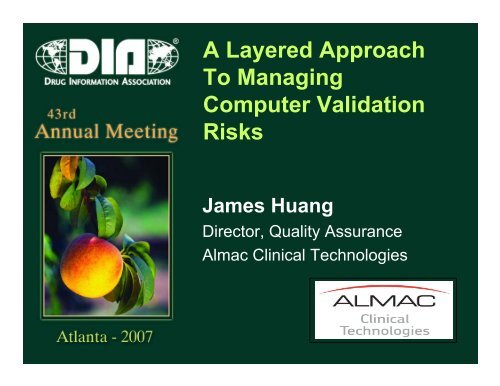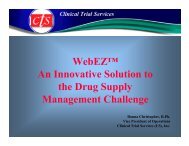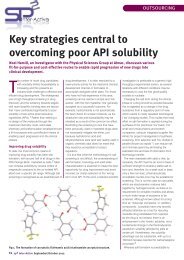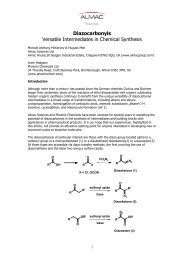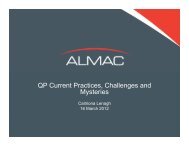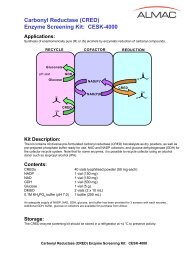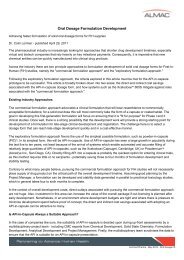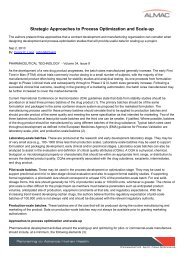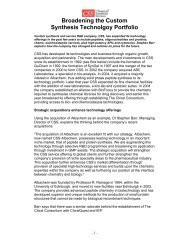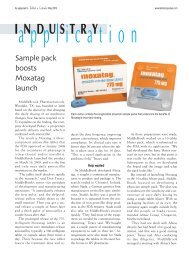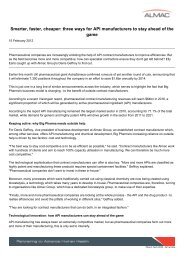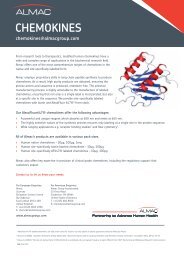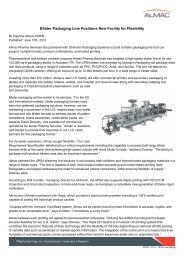A Layered Approach To Managing Computer Validation Risks - Almac
A Layered Approach To Managing Computer Validation Risks - Almac
A Layered Approach To Managing Computer Validation Risks - Almac
Create successful ePaper yourself
Turn your PDF publications into a flip-book with our unique Google optimized e-Paper software.
A <strong>Layered</strong> <strong>Approach</strong><br />
<strong>To</strong> <strong>Managing</strong><br />
<strong>Computer</strong> <strong>Validation</strong><br />
<strong>Risks</strong><br />
James Huang<br />
Director, Quality Assurance<br />
<strong>Almac</strong> Clinical Technologies<br />
Insert your logo in this area<br />
then delete this text box.
Overview of the Presentation<br />
• Overview Of Risk-Based <strong>Approach</strong> In<br />
Pharmaceutical Industry<br />
• <strong>Computer</strong> <strong>Validation</strong> <strong>Risks</strong> & Challenges<br />
• Introduction Into A 4-Layer Model<br />
<strong>Validation</strong> Methodology<br />
• A Case Study – <strong>Layered</strong> <strong>Approach</strong><br />
• Conclusions<br />
2
Overview Of Risk-Based<br />
<strong>Approach</strong> <strong>To</strong> The Industry<br />
• cGMPS FOR 21th CENTURY: A RISK-BASED APPROACH,<br />
August 2002<br />
– Merging Science-based Risk Management With An Integrated<br />
Quality Systems<br />
• INDUSTRY RESPONDED WITH OVERWHEMING<br />
ENTHUSIASM<br />
– Issued White Papers through Various Associations (ISPE, PDA,<br />
DIA etc.)<br />
• ICH CONSENSUS GUIDELINE QUALITY RISK<br />
MANAGEMENT (Q9), NOVEMBER 2005<br />
– Implementation (Step 5)<br />
– EU: <strong>To</strong> be notified.<br />
– MHLW: Adopted on September 1, 2006<br />
• FDA GUIDANCE FOR INDUSTRY - Q9 QUALITY RISK<br />
MANAGEMENT, JUNE 2006<br />
– FDA: Published in the Federal Register, June 2, 2006<br />
3
Principles Of ICH Q9 Guideline<br />
• ICH Quality Risk Management Scope: “<strong>Risks</strong> Related<br />
<strong>To</strong> Product Quality”<br />
• Define A Standard Framework For Risk Management<br />
• The Evaluation Of The Risk <strong>To</strong> Quality Should Be<br />
Based On Science & Linked <strong>To</strong> Patient Safety<br />
• The Level Of Effort, Formality And Documentation Of<br />
The Quality In Risk Management Process Should<br />
Commensurate With The Level Of Risk<br />
• A List Of Non-exhaustive Risk Evaluation Methods<br />
4
FDA Guidance For<br />
Industry Of ICH Q9<br />
• What’s In ICH Q9 Guidance<br />
– Q9 Has Broad Risk Concepts And Principles<br />
– Principles For Implementation<br />
– Elements Of Risk Assessment/Management Processes<br />
– Risk Management <strong>To</strong>ols<br />
• What Is Not In ICH Q9 Guidance<br />
– A “Cookbook” For Risk Management<br />
– A Specific Prescription For A Risk Management Program<br />
– An Exhaustive Treatment Of Theory<br />
– An Exhaustive List Of Methods & <strong>To</strong>ols<br />
5
Risk And Evaluation Methods<br />
• Risk Is Defined As A Function Of<br />
Likelihood And Severity<br />
• Q9 Listed A Variety Of Risk<br />
Analysis <strong>To</strong>ols And Defined By:<br />
– Quantitative Method<br />
– Qualitative Method<br />
– Expert Judgment<br />
6
<strong>Computer</strong> <strong>Validation</strong> <strong>Risks</strong> &<br />
Challenges<br />
• <strong>Computer</strong> Systems Are Becoming<br />
More And More Complex<br />
– Distributed Computing<br />
– Web-Based Application<br />
– Network Computing<br />
• Software Components Are Distributed In<br />
Different Machines <strong>To</strong> Collectively Provide<br />
Required Functionality<br />
• Each Component Operates In Its Own Hardware<br />
Platform & Operating System<br />
7
System Design Challenge<br />
• Network Infrastructure Design<br />
• Data Storage Design<br />
• Components Distribution Design<br />
• Security Design<br />
• Network Control & Monitor Design<br />
8
Deployment Challenge<br />
• Physical Network<br />
• Database Server<br />
• Application Server<br />
• Security<br />
• Network Traffic Control & Load<br />
Balancing<br />
9
Dynamic Configuration<br />
Challenge<br />
• Network Connectivity Configuration<br />
• Security Configuration<br />
• Application Configuration<br />
• Data Service Configuration<br />
10
System <strong>Validation</strong> - Scope<br />
• Infrastructure<br />
– Network Infrastructure<br />
–Data Service<br />
– Security<br />
• Application<br />
– Application Server<br />
– Application Client<br />
11
System <strong>Validation</strong> - Methods<br />
• System Development Life Cycle<br />
– User Requirement Specifications<br />
– Functional Specifications<br />
– Design Specifications<br />
– Implementation<br />
– Testing<br />
– Change Control<br />
12
4-Layer Model <strong>Approach</strong> <strong>To</strong><br />
<strong>Computer</strong> <strong>Validation</strong><br />
• What Is & Why <strong>Layered</strong> <strong>Approach</strong>?<br />
– Divide And Conquer<br />
– Separate Infrastructure From Application<br />
– Separate Network From Data Service<br />
– Separate Data Service From Applications<br />
13
<strong>Layered</strong> View Of Distributed<br />
System<br />
EDC APP<br />
IXRS<br />
Web-based<br />
Document App<br />
IVR Data Transfer<br />
Business to Business Application Layer<br />
(Applications)<br />
FAX/EMAIL SQL Servers Web Server<br />
Shared Application and Data Service Layer<br />
Unix<br />
Windows XX<br />
BizTalk<br />
Security Services<br />
Operating Environment<br />
Infrastructure<br />
Network Layer (Switch, router, firewall etc.)<br />
IT Physical Infrastructure Layer<br />
14
IT Physical Infrastructure Layer<br />
• IT Physical Layer Components:<br />
– Networking Switches & Routers<br />
– Load Balancing Device, Firewall/Security Device<br />
– Cabling & Physical Connectivity<br />
– Network Monitoring & Controlling Device<br />
– Physical Servers<br />
• <strong>Validation</strong> Focus:<br />
– Vendor Qualification And Standards<br />
15
Operating Environment<br />
• Operating Environment Components:<br />
– Operating System<br />
– Directory Service<br />
– Object Name Service<br />
– User Authentication Service<br />
– Integration Service - MS BizTalk<br />
• <strong>Validation</strong> Focus:<br />
– Dynamic Configuration<br />
16
Shared App and Data Service Layer<br />
• Application Servers<br />
– Web Services<br />
– Database Services<br />
– Document Management Services<br />
– FAXING/EMAIL Services<br />
– Data Reporting Services<br />
• <strong>Validation</strong> Focus:<br />
– Installation Qualification And Operational<br />
Qualification<br />
17
Application Layer<br />
• Business Applications<br />
– IVRS Applications<br />
– ePRO Applications<br />
– Web Based Application<br />
– Distributed Applications Such As Data<br />
Transfer, Web Reports, etc.<br />
• <strong>Validation</strong> Focus:<br />
– Full Life Cycle System <strong>Validation</strong><br />
18
Advantage of <strong>Layered</strong> Model<br />
• Reflects Technical Architecture<br />
• Reflects Organizational Structure<br />
• Separates & Isolates Issues In Different<br />
Universe Of Problems<br />
• Well Defined Interface Between Layers<br />
• Applies SDLC In Each Layer With<br />
Different Risk Focuses<br />
19
Case Study-Case Description<br />
• <strong>Almac</strong> Clinical Technologies Is An<br />
IVR/EDC System Vendor Which:<br />
– Provides IVR/EDC Consulting Services<br />
– Develops IVR/EDC Systems<br />
– Hosts Clinical Trial Data<br />
– Reports/Transfers Data <strong>To</strong> Sponsors<br />
20
Case Study - Host Environment<br />
• 20 Network Switches & 5 Routers<br />
• 4 Firewall Devices<br />
• 10 Database With 3 Replicates By SAN<br />
• 5 Web Servers<br />
• 2 BizTalk Services<br />
• Over 200 IVRS/EDC Applications<br />
• More Than 86000 Users Worldwide<br />
21
Analyze and Prioritize Risk<br />
• Most Important Assets<br />
– IT Infrastructure<br />
– IVRS/EDC Systems<br />
– Clinical Research Data<br />
– Institution Knowledge<br />
• Inventory Assessment Of <strong>Computer</strong> Systems<br />
– Regulated vs Non-regulated System<br />
– Infrastructure vs Clinical Trial Applications<br />
– Standard vs Non-standard Hardware<br />
– Standard vs Non-standard Software<br />
– Disaster Recovery Solution<br />
22
Risk Measurement<br />
• Frequency Of Risk Event – Statistical Methods<br />
– Track Actual Hazard Events (Incident Report)<br />
– Analyze The Causes Of Hazard Events (Link <strong>To</strong> Asset)<br />
– Calculate The Frequency Of The Occurrences<br />
• Severity Of Risk Event – Mixed Methods<br />
– Severity Of Risk By Quantitative Measurement<br />
– Severity Of Risk By Qualitative Measurement<br />
– Severity Of Risk By Expert Judgment Measurement<br />
• Normalize All Three Measurements - Quantitative<br />
– For Example Scale1-10<br />
– Loss In Dollar Or % Of <strong>To</strong>tal Revenue Loss<br />
23
Organizational Risk Map<br />
Risk Frequency/Severity Chart<br />
12<br />
10<br />
8<br />
6<br />
4<br />
2<br />
0<br />
Doc error<br />
Standard HW/SW<br />
Infrastructure,<br />
Drug<br />
Assignment<br />
Rand<br />
Blinding<br />
Security<br />
Data Error<br />
System<br />
Availability<br />
Login in error<br />
Coding error<br />
non-compliance<br />
Risk Factors In The Order Of Frequency<br />
24<br />
Severity
Case Study - <strong>Validation</strong> Strategy<br />
• Infrastructure Qualification Plan - Bottom 3 Layers<br />
– Vendor Assessment<br />
– Standards<br />
– Customer Support<br />
– Maintenance – Configuration Management<br />
– IQ/OQ<br />
• IVRS/EDC Application <strong>Validation</strong> Plans –Clinical App<br />
– System SDLC<br />
– Patient Safety<br />
– Data Integrity<br />
– Data Security<br />
– Compliance<br />
25
Case Study – Org. Structure<br />
• Assign <strong>Validation</strong> Staff At Infrastructure Level<br />
• Qualify The Bottom Three Layers By IT<br />
Organization<br />
• Validate Business Application By End Users<br />
• Perform PQ By The Combination Of User &<br />
IT Organizations<br />
26
Case Study - Milestone &<br />
Deliverables<br />
• Qualification Plan and <strong>Validation</strong> Plans<br />
• Project Tasks And Responsibility Matrix<br />
• Conceptual And Physical Design Document<br />
• Hardware/Software Inventory<br />
• IQ/OQ For Each Component<br />
• PQ For Integrated System<br />
27
Case Study - Milestone &<br />
Deliverables<br />
• Vendor Audit/Assessment Reports<br />
• System Life Cycle SOP<br />
• System Maintenance SOP<br />
• Change Control SOP<br />
• Physical & Logical Security SOP<br />
• Application Deployment SOP<br />
• Infrastructure Qualification Summary Report<br />
• IVR/EDC System <strong>Validation</strong> Summary Report<br />
28
Conclusions<br />
• Clearly Defined Layers Of Computing Environment<br />
• Quantitatively Associated <strong>Risks</strong> <strong>To</strong> Different Layers<br />
• Developed Risk Maps <strong>To</strong> Major Business Asset<br />
• Defined Risk-Based <strong>Validation</strong> Strategy For <strong>Computer</strong><br />
System <strong>Validation</strong> Based On <strong>Layered</strong> <strong>Approach</strong><br />
• Developed Repeatable Process <strong>To</strong> Execute The<br />
Strategy<br />
• Significantly Improved Efficiency Of <strong>Validation</strong> Task<br />
• Enjoyed The Highest Audit Rating Among Competitors<br />
29


